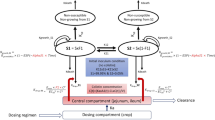Abstract
Escherichia coli O157:H7 is an emerging food and waterborne pathogen in the U.S. and internationally. The objective of this work was to develop a dose-response model for illness by this organism that bounds the uncertainty in the dose-response relationship. No human clinical trial data are available for E. coli O157:H7, but such data are available for two surrogate pathogens: enteropathogenic E. coli (EPEC) and Shigella dysenteriae. E. coli O157:H7 outbreak data provide an initial estimate of the most likely value of the dose-response relationship within the bounds of an envelope defined by beta-Poisson dose-response models fit to the EPEC and S. dysenteriae data. The most likely value of the median effective dose for E. coli O157:H7 is estimated to be approximately 190[emsp4 ]000 colony forming units (cfu). At a dose level of 100[emsp4 ]cfu, the median response predicted by the model is six percent.
Similar content being viewed by others
References
B.P. Bell, M. Goldoft, P.M. Griffin, et al. (1994). Journal of the American Medical Association 272(17), 1349.
D. Bieber, S.W. Ramer, C.-Y. Wu, et al. (1998). Science 280, 2114.
R.L. Buchanan, M.P. Doyle (1997). Foodtechnology, 51(10), 69.
CDC (Centers for Disease Control and Prevention) (1997). Morbidity and Mortality Weekly Report 46(12), 258.
surv.htm)} (1998).
CDC (Centers for Disease Control and Prevention) (1999a). Unpublished data.
CDC (Centers for Disease Control and Prevention) (1999b). Unpublished data.
CDC (Centers for Disease Control and Prevention) (2000). Morbidity and Mortality Weekly Report 49(10), 201.
P.R. Cieslak, S.J. Noble, D.J. Maxson, et al. (1997). American Journal of Public Health 87(2), 176.
C. Crockett, C.N. Haas, A. Fazil, et al. (1996). International Journal of Food Microbiology, 30(1–2), 87.
M.W. Donnenberg, M.W.A. Donohue-Rolfe, G.T. Keusch (1989). Journal of Infectious Diseases 160, 452.
M.P. Doyle, J.L. Schoeni (1984). Applied Environmental Microbiology 48(4), 855.
S. Falkow (1996). In: Escherichia coli and Salmonella (Ed. F.C. Neidhardt). ASM Press, Washington, DC, p. 2723.
J.M. Farber, W.H. Ross, J. Harwig (1996). International Journal of Food Microbiology 30:145.
S. Ferson (1996). Human and Ecological Risk Assessment 2(4), 990.
J.E. Galan, P.J. Sansonetti (1996). In: Escherichia coli and Salmonella (Ed. F.C. Neidhardt). ASM Press, Washington, DC, p. 2757.
P.M. Griffin (1995). In: Infections of the Gastrointestinal Tract (Eds. M.J. Blaser, P.D. Smith, J.I. Ravdin, et al.). Raven Press, Ltd., New York, p. 739.
C.N. Haas (1983). American Journal of Epidemiology 118(4), 573.
C.N. Haas (1994). Risk Analysis 14(6), 1097.
C.N. Haas J.B. Rose, C. Gerba, S. Regli (1993). Risk Analysis 13(5), 545.
C.N. Haas, A. Fazil, J.B. Rose, C.P. Gerba (1999). Quantitative Microbiology 1, 89.
D.D. Hancock, T.E. Besser, D.H. Rice, et al. (1998). Preventative Veterinary Medicine 35(11), 19.
C. Hedberg, F. Angulo, J. Townes, et al. (1997). Differences in Escherichia coli O157:H7 annual incidence among FoodNet active surveillance sites. FoodNet Conference, Baltimore, MD, June 22–26, 1997.
D.L. Holcomb, M.A. Smith, G.O. Water, et al. (1999). Risk Analysis 19(6), 1091.
R.C. June, W.W. Ferguson, M.T. Worfel (1953). American Journal of Hygiene 57, 222.
V.K. Juneja, O.P. Snyder, Jr., A.C. Williams, B.S. Marmer (1997). Journal of Food Protection 60, 1163.
H. Kassenborg (1999). Personal communication (Minnesota Department of Health).
H. Kassenborg, C. Hedberg, M. Evans, et al. (1998). In: Program and Abstracts of the International Conference on Emerging Infectious Diseases. American Society of Microbiology, Washington, DC, March 8–11, 1998, p. 50.
M.M. Levine, H.L. Dupont, S.B. Formal, et al. (1973). Journal of Infectious Diseases 127(3), 261.
M.M. Levine, E.J. Bergquist, D.R. Nalin, et al. (1978). Lancet 1(8074), 1119.
H.M. Marks, M.E. Coleman, C.-T. Lin, T. Roberts (1998). Risk Analysis 18(3), 309.
P. Mead, P.M. Griffin (1998). Lancet 352, 1207.
P. Mead, L. Slutsker, V. Dietz, et al. (1999). Emerging Infectious Diseases, 5(5), 607.
J.P. Nataro, J.B. Kaper (1998). Clinical Microbiology Reviews 11(1), 142.
S.M. Ostroff, J.M. Kobayashi, J.H. Lewis (1989). Journal of the American Medical Association 262(3), 355.
C.H. Pai, J.K. Kelly, G.L. Meyers (1986). Infection and Immunity 51(1), 16.
S. Regli, J.B. Rose, C.N. Haas, C.P. Gerba (1991). Journal of the American Water Works Association 83(11), 76.
L.W. Riley, R.S. Remis, S.D. Helgerson, et al. (1983). New England Journal of Medicine 308, 681.
J.B. Rose, C.N. Haas, S. Regli (1991). American Journal of Public Health 81(6), 709.
A.A. Salyers, D.D. Whitt (1994). Bacterial Pathogenesis: A Molecular Approach. American Society for Microbiology Press, Washington, DC, Chapter 16.
F. Seiler, J. Alvarez (1996). Risk Analysis 16(1), 5.
A. Thayyar-Madabusi (1998). A Quantitative Risk Assessment Model for Listeria monocytogenes and Escherichia coli O157:H7. Drexel University, M.S. Thesis, Philadelphia, PA.
USDA/FSIS (US Department of Agriculture, Food Safety and Inspection Service) (1996). Federal Register 61(144), 38805.
USDA/FSIS (US Department of Agriculture, Food Safety and Inspection Service) (2000). Risk Assessment of E. coli O157:H7 in Ground Beef (Draft) (Available at: fsis Docket No. 97-013P).
D. Vose (1996). Quantitative Risk Analysis: A Guide to Monte Carlo Simulation Modeling. John Wiley and Sons, Ltd., West Sussex, England.
Author information
Authors and Affiliations
Rights and permissions
About this article
Cite this article
Powell, M.R., Ebel, E., Schlosser, W. et al. Dose-Response Envelope for Escherichia coli O157:H7. Quantitative Microbiology 2, 141–163 (2000). https://doi.org/10.1023/A:1011557402204
Issue Date:
DOI: https://doi.org/10.1023/A:1011557402204




